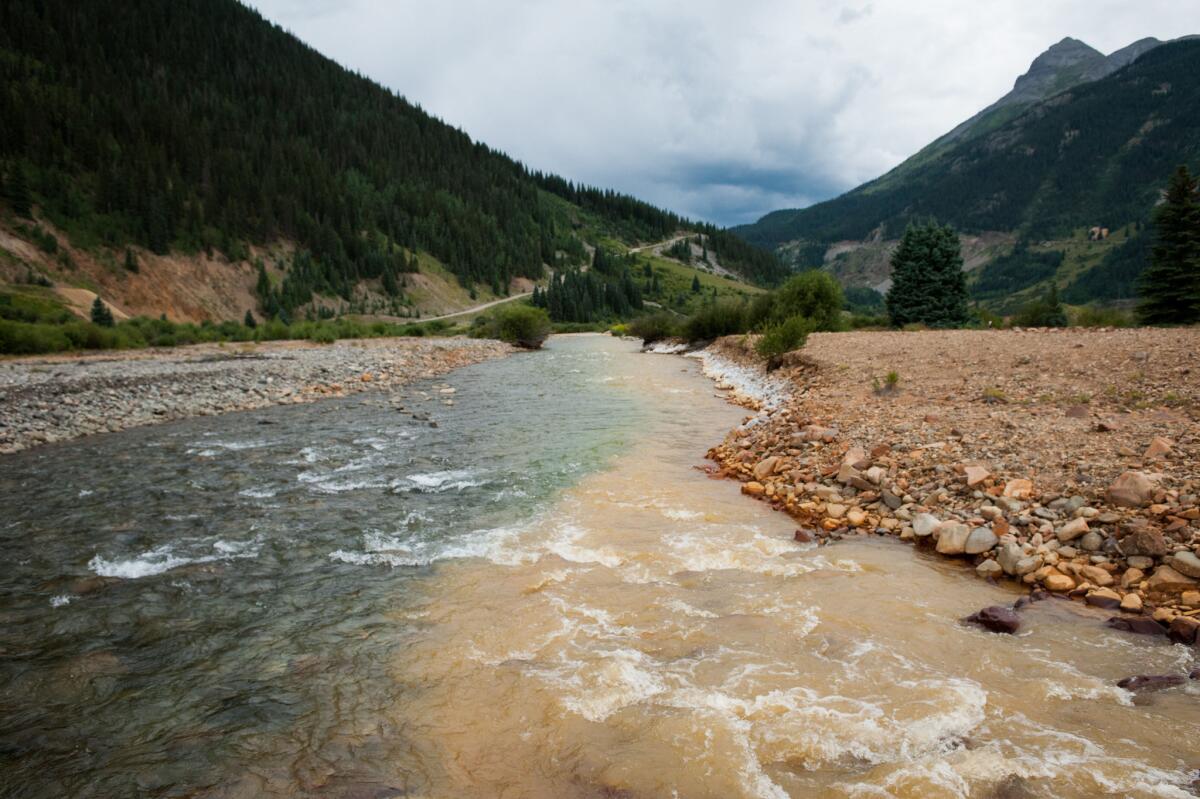EPA chief says polluted Animas River ‘seems to be restoring itself’

Cement Creek, which was flooded with millions of gallons of mining wastewater, merges with the Animas River in Silverton, Colo.
Friction continued Wednesday between state and federal officials over whether it’s safe to reopen the Animas River in southern Colorado to recreation one week after 3 million gallons of spilled mine waste turned the waters a sickish mustard color.
Colorado officials insist that the concentration of metals in the river is decreasing and want the river reopened to boating and fishing, both crucial elements of the state’s economy. And they want the federal Environmental Protection Agency, whose workers triggered the spill last week at the Gold King Mine, to move faster in its assessment of the river’s health.
EPA Administrator Gina McCarthy on Wednesday toured the riverside in Durango, Colo., saying tests showed the levels of various metals had returned to normal.
“I visited the river and took a look at it myself, and the good news is that it seems to be restoring itself,” she said. “We’re hoping for a return to some sense of normalcy for the use of this river, but the EPA is letting science be its guide.”
------------
FOR THE RECORD:
River spill: In the Aug. 12 Section A, an article about the contamination of Colorado’s Animas River referred to Jared Blumenfeld as an Environmental Protection Agency spokesman. He is the EPA’s administrator for the Pacific Southwest Region. —
------------
See the most-read stories this hour >>
Earlier, Colorado Gov. John Hickenlooper’s office released a statement that symbolized the frustration felt by thousands of residents who have been told to stay away from the river until further notice.
“Even though the state and EPA may disagree on the timing, the state’s initial analysis shows the water is significantly improved with little risk to human health at this time,” the statement said. “Reopening the river is a local decision so the sooner we give the community and local officials the facts, the better for everyone, especially those who rely on the river for business.”
Tuesday brought a terse exchange between Hickenlooper and Shaun McGrath, a regional administrator for the EPA, who asked the governor to stop making comments that the river was returning to good health.
“It doesn’t show where we are at right now,” McGrath said. “You have to have a couple of days of data to show that you’re actually back to baseline conditions, and we’re not there yet.”
A miffed Hickenlooper responded: “That’s nonsense.” He said closed businesses were waiting for word of the river’s reopening.
Rusty Harris-Bishop, a Superfund project manager for the EPA who is at the site of the spill, said the decision to reopen the river rests with the sheriff of La Plata County.
“We’re trying to give him the proper criteria to make that decision,” he said. “Like everyone else, we want to get that river open, but we want it to be safe in the long term.”
NEWSLETTER: Get the day’s top headlines from Times Editor Davan Maharaj >>
An EPA official said McCarthy was pushing for timely results of any study on metals — such as arsenic, copper, lead and zinc — set loose in the river.
“The word we’re getting is, ‘Either show that it’s safe or it isn’t,’” said the official, who asked not to be named because he was not authorized to comment on the situation. “She’s equally impatient.”
Water rafting companies have been closed for days, turning away customers, but one company said Wednesday it wanted to be sure of the river’s safety before allowing customers to return.
“We certainly want to get back to business. A lot of us who are river users ourselves want to get back out there, but we don’t want to put people in harm’s way,” said Matt Gerheardt, manager of the retail store at 4 Corners Whitewater in Durango. “We want to make sure that the contaminant levels are not an issue. The water quality tests have to be verified, and we understand that takes time.”
Speaking at the EPA command center in Durango, McCarthy said her agency “was working hard throughout the night and day” to assess consequences of the spill.
“We want to reassure everyone that the EPA does take full responsibility for the spill,” which took place at the long-closed mine north of Durango, she said. “No agency could be more upset about this incident and more dedicated to doing our job and doing it right.”
McCarthy said 100 EPA experts were on the ground in Colorado and there were hundreds more in Washington on the case, adding that the agency would conduct its own investigation of the spill as well as solicit a review from an outside agency.
She said the EPA was also reviewing practices at other closed mines nationwide “to avoid a repeat of this mistake -- to make sure there is no potential for another release like this.”
Meanwhile, New Mexico officials said Wednesday that residents who rely on the Animas River were anxious to get back to normal.
Michele Truby-Tillen, spokeswoman for the San Juan County Office of Emergency Management in New Mexico, said that despite various tests of the river water, the process was not moving fast enough for frustrated residents.
Many people have been ordered not to drink well water, and some residents are still coming to Farmington to take showers.
“We’re telling people that the river will remain closed until we can get data that says it’s safe,” she said. “People are frustrated, but we’re doing this for them. If we don’t hold off and people get sick, then who are they going to blame?”
Twitter: @jglionna
ALSO:
Jimmy Carter says he has cancer that has widely spread
Voters to decide whether Ohio will become first Midwest state to legalize pot
As Washington’s peculiar drought continues, Puget Sound cities asked to cut water use 10%
More to Read
Sign up for Essential California
The most important California stories and recommendations in your inbox every morning.
You may occasionally receive promotional content from the Los Angeles Times.











